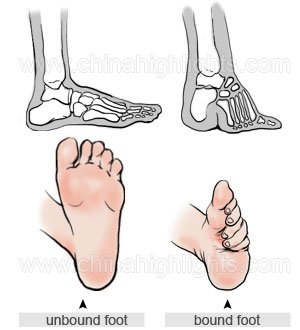
Foot binding is an ancient tradition that has been practiced for centuries, where women and girls have their feet bound and reshaped for aesthetic purposes. It is a painful and dangerous procedure that has been widely criticized, yet it still exists in some parts of the world in modern day. In this blog post, we will explore the shocking history of foot binding and how it is still being practiced today.

What Is Foot Binding?
Foot binding was a traditional Chinese practice that dates back to the 10th century and was practiced until the early 20th century. This painful process involved tightly wrapping the feet of young girls in order to make them shorter and narrower. The binding would eventually cause the bones in the feet to break and fuse, forming a unique “lotus” shape. Women with bound feet were seen as more desirable and were often favored for marriage.
The process began at a young age and was typically carried out by a mother or grandmother. In the early stages, feet were washed with warm water and massaged before being tightly wrapped with strips of cloth. The bindings were tightened over time and the feet reshaped into their desired shape. Women would often have to wear shoes with wooden soles to keep their feet from becoming deformed.
The practice of foot binding was seen as an expression of beauty, status, and power. While it was traditionally seen as a way to make a woman more desirable, many modern studies have found that it can lead to long-term physical and mental health complications.
A Brief History of Foot Binding
The practice of foot binding is believed to have originated in China in the 10th century. It was practiced mainly among upper-class families, as an indication of status and beauty. The practice became widespread during the Song Dynasty (960 - 1279). At its height, foot binding was a part of Chinese culture and was seen as an essential part of a young woman's upbringing.
During this time, young girls as young as four or five years old had their feet tightly bound with bandages and cloth. This process involved breaking the arch and bones of the foot, making them as small as possible. To achieve the desired results, many girls would have their feet bound for years and sometimes decades. The binding process was painful and often led to deformities and disabilities.
Foot binding was seen as a mark of femininity, beauty and obedience. Women with bound feet were considered more attractive and desirable and were usually the most sought after wives by men. Foot binding also meant that women were unable to work and had to rely on their husbands or family for support.
By the late 19th century, the practice of foot binding began to decline as modern ideas of emancipation spread through China. It was eventually outlawed by the Chinese government in 1911 as a result of pressure from foreign powers. Despite this, there are still reports of foot binding practices in rural areas of China today.
The Modern Day Practice of Foot Binding
Despite its ancient origins, foot binding is still practiced today in some parts of the world. In China, the practice is now illegal but there are still cases of women and girls who continue to bind their feet. In other parts of the world, such as India and Nepal, the practice is not illegal and it is often done as a form of cultural expression.
In recent years, there has been a resurgence of interest in foot binding in certain parts of the world. The resurgence is largely attributed to the influence of fashion trends and traditional customs in places like South Korea, where celebrities have been spotted wearing “traditional” bound feet.
While it is sometimes seen as a way to enhance a person’s beauty or status, there are still many dangers associated with foot binding. People who bind their feet risk long-term physical damage and health complications due to the tight binding, which can cause permanent deformities in the toes, feet, and ankles. Additionally, people who bind their feet may experience difficulty walking or standing for extended periods of time due to their limited mobility.
The Dangers of Foot Binding
Foot binding is an ancient practice that has been around for centuries, but it has been linked to many health risks. Foot binding can lead to a range of physical ailments and even permanent disability. This is due to the fact that when a woman’s feet are bound, the bones in her feet will be compressed, which affects their growth and development. This can lead to pain, discomfort, and mobility problems.
In addition to these physical problems, foot binding also carries emotional risks as well. Many women who undergo foot binding experience feelings of low self-esteem and depression due to their inability to participate in physical activities or perform basic tasks. Foot binding can also be seen as a form of oppression, as it was often used to limit women’s ability to move freely and take part in society.
For those who have their feet bound, the effects can be long-lasting and difficult to reverse. Even if the bindings are removed, the deformity of the feet remains, leading to lifelong pain and immobility. Women who bind their feet are also at risk of developing foot infections or ulcers due to the restricted movement. In extreme cases, untreated ulcers can lead to amputation of the foot or even death.
Why Do People Still Bind Their Feet Today?
Foot binding has a long and painful history that continues to exist in some parts of the world today. Although it is not as widespread or extreme as it used to be, there are still people who bind their feet, usually for cultural or aesthetic reasons.
One of the main reasons why people still bind their feet is because of tradition. Some people in countries like China and India still practice foot binding as part of their culture and history, believing that it will make them more attractive.
In addition, some women believe that foot binding can make them look more feminine and desirable. In certain cultures, small feet are seen as a sign of beauty and refinement, so women may opt to bind their feet to achieve this look.
Modern shoes also play a role in the continued practice of foot binding. In recent years, fashion trends have embraced the idea of having smaller feet, with shoes designed to imitate the effects of foot binding. Women are able to achieve a similar look without actually having to bind their feet.
At the end of the day, the practice of foot binding is still dangerous and should not be taken lightly. It can lead to serious health problems and even disability if not done properly. Despite this, there are still people who continue to practice this tradition for cultural or aesthetic reasons.
How modern shoes mimics foot binding
Foot binding was a painful practice that was common in China until it was outlawed in 1911. The feet of young girls were tightly bound to prevent further growth, resulting in deformed feet called lotus feet. This process was believed to make a woman more desirable and bring her family honor.
Today, many modern shoes continue to mimic the look of foot binding. For example, high-heeled shoes restrict the foot and ankle, creating an unnatural arch in the foot. Pointed-toe shoes, such as stilettos, also cause discomfort and can cause damage to the toes and foot over time. Even though these shoes are not as extreme as foot binding, they can still cause long-term damage.
The lasting effects of foot binding are still seen today, but it is important to be aware of how our modern shoes can cause similar issues. Foot binding was a harmful practice that caused a great deal of physical pain and trauma. We should be mindful of the risks posed by our footwear and work to create healthier options.





Comments
I have never heard or seen foot binding in India. It’s NOT an Indian tradition. I am originally from North India., but lived all over India. Born and raised there, so your statements seem very bizzare.